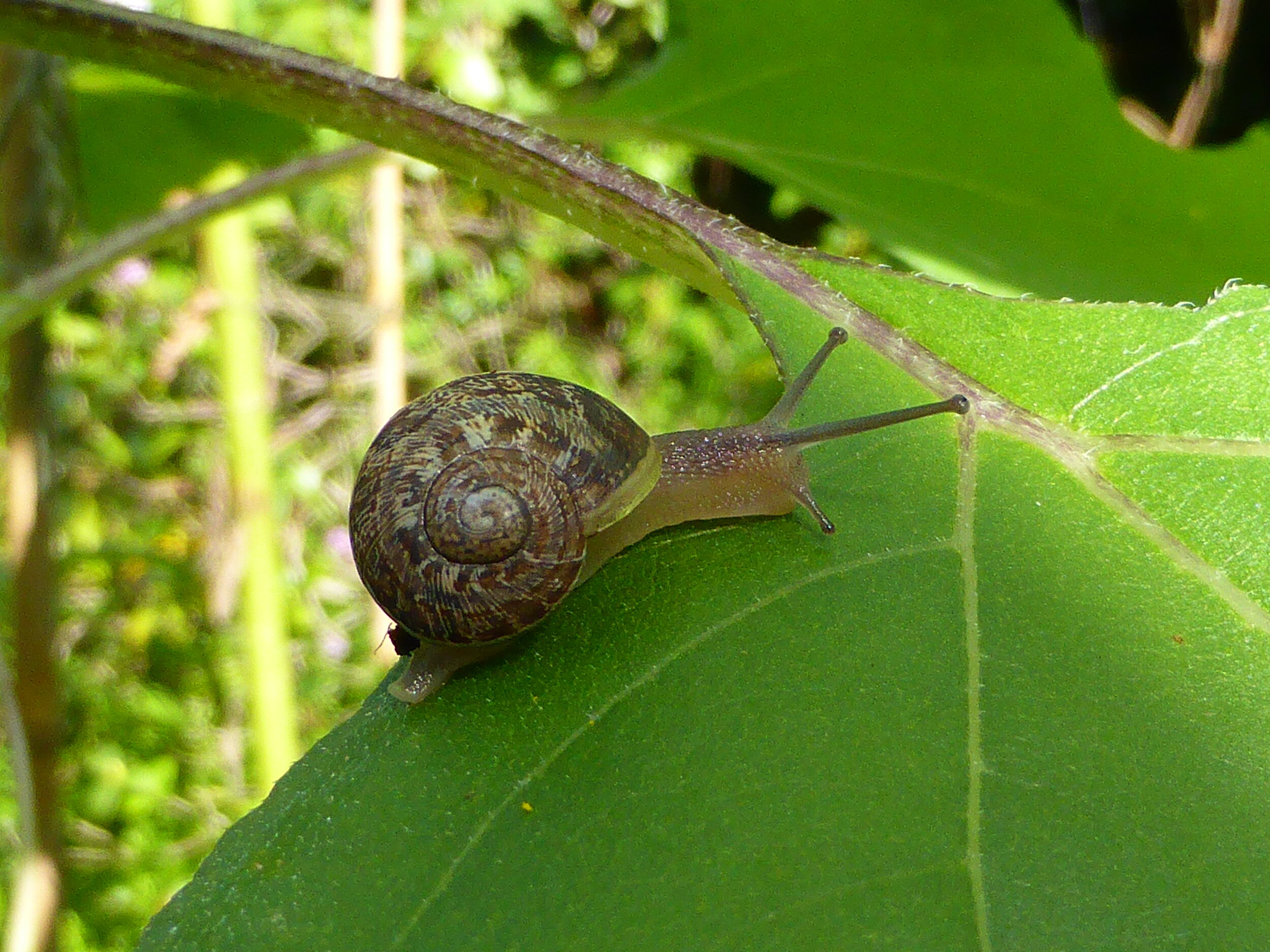In lots of ways the most destructive of our UK garden pests, and the bane of many gardeners lives, these pesky critters do so love to nibble on our prize plants. I’m sure many meet their fate under the wellie boot of many of you!
Which of course might be satisfying for a fleeting moment, however what you really want to know is how to stop the little beggars…
Our nocturnal enemies
And how to stop them!
Well, there’s good news in that the gardener has lots he can have up his or her collective sleeve, to try and limit the damage they’ll do to your treasured perennials and your delicate annuals.
They say prevention is better than cure, so that’s what we’ll concentrate on…because once the damage is done, you’ll be left with some very tatty leaves!
Obstacle courses
Make it hard for them! Strulch is one option.
Slugs and snails move, as I’m sure you know (yuk), via a mucus membrane on their ‘foot’. They need moisture to move around and won’t like dry, rough surfaces. For that reason, a garden mulch is a huge obstacle to them. Now you can use all sorts….grit is said to work well, and gravel, but not everybody wants to but these all over their borders as they aren’t organic. And without a membrane underneath, they can get really muddy and become ineffective.
Bark mulch is perhaps the coarsest, and works really really well against slugs and snails. It’s important to put on a thick layer, I’d suggest 3-4inches (7.5-10cm) at least, to really hamper the little sods!
Coarse Bark mulch
Really helps to ruin their eating habits!
There’s also a lovely product which we now stock, called Strulch, an organic mulch made from mineralised straw. It goes a long way, it ‘knits’ together once it’s been applied so tends not to blow around like coarse bark. And boy oh boy it looks WONDERFUL when it’s down.
We’re one of the only stockists at the moment in this part of the UK, after being recommended it by a customer, we thought we’d give it a whirl. And we’re very glad we did! At £8.50 per 100L bark, its marginally more expensive than bark (£7.50), but we think it goes that little bit further.
Now you probably already know that mulches like this are always best in dry weather, as the surfaces dry well and slugs just don’t want to try getting over them, for fear of kicking the sluggy bucket.
The other advantage of course, is that mulches really help to control weeds by preventing germination. It slowly rots into the ground, improving the soil, increasing populations of earthworms, and keeps moisture in the ground for your precious plants.
Only one problem with that, of course….we’ve all ended up in the UK and its beautiful but unpredictable Summers! So much as a good thick bark mulch is a huge bonus, it isn’t foolproof.
So what else can we do?
Use barriers
to protect your babies
If you grow your prized possessions in pots, then certain barriers have been proven to significantly reduce slug and snail problems. Now since plants like the gorgeous Hosta grows really well in pots, this could be a really good way to concentrate your efforts on the plants you really want to protect.
Copper tape has been used to good effect for many years, and I have to admit I’ve always been a little bit cynical…until I read up on it. Copper causes a static discharge of electricity when the slug or snail happens upon it. Watch a video on the internet and you’ll see that they hate it! Definitely worth investing to keep your potted plants tatter free.
Break open your Piggy Bank!
Put your coppers to good use!
There’s evidence to show that copper coins can also help, if used in the tops of pots. Being copper plated, there’s no reason that they wouldn’t work in the same way as copper banding….it’s probably cheaper too!
Another use for Vaseline?
And why not….
The more you delve into the subject, the more you discover weird and wonderful remedies for beating slugs & snails. So it seems that Vaseline is also widely used in the perennial fight against these pesky molluscs….apparently the best results are when the Vaseline is mixed with table salt, then applied around the edge of pots in much the same way as copper tape. They are not only repelled by the Vaseline, but run a mile from the salt too! Of course other Petroleum Jellies are available…and if you look on Amazon you’ll save yourself a fortune compared to the brand leader!
Enough to buy a little bottle of Eucalyptus oil and add a couple of drops to make it even more effective?
On a similar vein, Vicks jelly is also said to work well. Admittedly quite messy to apply, but if placed around the rims of your pots of plants, the stuff should last all season long…probably best not to move them around too much after smearing jelly all over them!
Fried, poached or scrambled?
Doesn’t matter…just don’t chuck the shells!
Another traditional remedy said to work well by many, is the application of crushed eggshells around the base of your beloved plants. The sharp, rough edges are not welcomed by the slimy critters, so be sure to use a good layer, ideally 2 inches wide (5cm) in a band around your plants, so they can’t cross it easily. And the shells will slowly release nutrition into the soil too!
A buffet for birds
Bigger birds love ‘em!
Now you may already know thrushes love snails, it’s such a shame their numbers are on the decline. But slugs are beloved by magpies, and other members of the crow family. So you could always (if you can bear it) create your own island of water in a big saucer, and see if any locals would like to help themselves to a free buffet! Its the perfect way to get rid of them if you’re an insomniac and find yourself inspecting your borders in the middle of the night!
Fancy a pint?
What a way to go!
Now this one is tried and trusted, and at least the little beggars won’t know what’s hit them…it appears any old beer will do and I’m not sure many of you fellas** will object to pouring a little of your favourite tipple in a dish, if it returns a catch like this! Beer traps are available everywhere, but there’s a hundred DIY options too…
** Apologies for any sexism here….I’m not sure they like Prosecco as much?
Or a coffee instead?
That works too!
OK, so not a coffee trap as such, because they hate it! But if you have a hankering for caffeine, then used coffee grounds are said to work wonders, especially if used as a half inch thick ring around your favourite plants. Now the more entrepreneurial ones among you can chat up your local coffee shop (goodness knows there are enough of them), and I bet you’ll get all the used coffee grounds you can handle. Added to their repellency, they also decompose into the garden soil, adding lots of nutrition, trace elements, and help to lower the pH, which is a great thing for lots of plants in the garden!
Invasion of the Body Snatchers
Great for Summertime
Thank goodness for scientists. There’s always something interesting to discover in nature, and this time, they’ve found some little worms called nematodes, whose favourite meal is, you’ve guessed it….slugs! We use a similar product on the nursery, to control the larvae of Vine Weevil, and we reckon we get a 99% success rate. They are amazing. Now you won’t find these in Garden Centres as they have a limited shelf life, so you have to send away for them. But as long as you follow the instructions, we think these are definitely worth a try. Temperature sensitive, they won’t provide year round protection I’m afraid.
Slug pellets
Organic or chemical….
‘Slug Pellets’ have long been accepted to do the job, although they’ve been swamped in controversy over the years, as they kill slugs and snails by the use of the chemical metaldehyde, which some say can then enter the food chain through birds eating the poisoned slugs and snails. The manufacturers dispute this, and it’s not for us to take a side. All we will say is that used sparingly, they work a treat. It’s up to you if you wish to use them, or take advantage of the many chemical free versions available these days, like Slug Stop from Growing Success.
So what do we use?
Give you three guesses…
So after all the various options open to you, where do you stand? Well all we’d say is to give the non-chemical options a go first. And if, after all that, you still struggle, by all means give the traditional metaldehyde pellets a go.
What will we do? After committing to growing over 6000 Hostas this year (yes 6000!), we’ve done lots of research and we are not using any chemicals whatsoever, at least until we’ve exhausted our first options.
First, we will be growing our pots of hostas on a base of stone chippings, so that the ground itself will hopefully remain fairly dry for the majority of the time. Slugs and snails hate it dry, so that should help massively.
Second, we’re going to begin a spray programme based purely on the use of garlic spray. Slugs and snails prefer bland salads! Anything with too much flavour and they will tend to leave it alone….so we’re hoping to trick them by thinking they’ve crawled into a fancy restaurant…
Would you like the recipe?
Boil two full bulbs of garlic in 2 litres of water, until the bulbs are soft and squidgy. break the cloves up with the back of a fork, and strain the mixture, removing all skins and garlicky bits, so you’re left with an ‘aromatic’ elixir.
This is your concentrate, so decant it into a bottle once cooled.
Use two tablespoons of the concentrate mixed in 5 litres of water, and use this to water over the leaves of your Hostas, ideally in the afternoon and ideally on a dry day where possible. We’ll use a knapsack sprayer, but there’s nothing wrong with a watering can.
The garlic taste will linger on the leaves and act as a wonderful natural deterrent, but will need reapplying regularly, we’ll be doing it once a week.
And that’s it. So we really have only one more thing to say…..
THIS IS WAR
Make sure you’re well armed this year!














